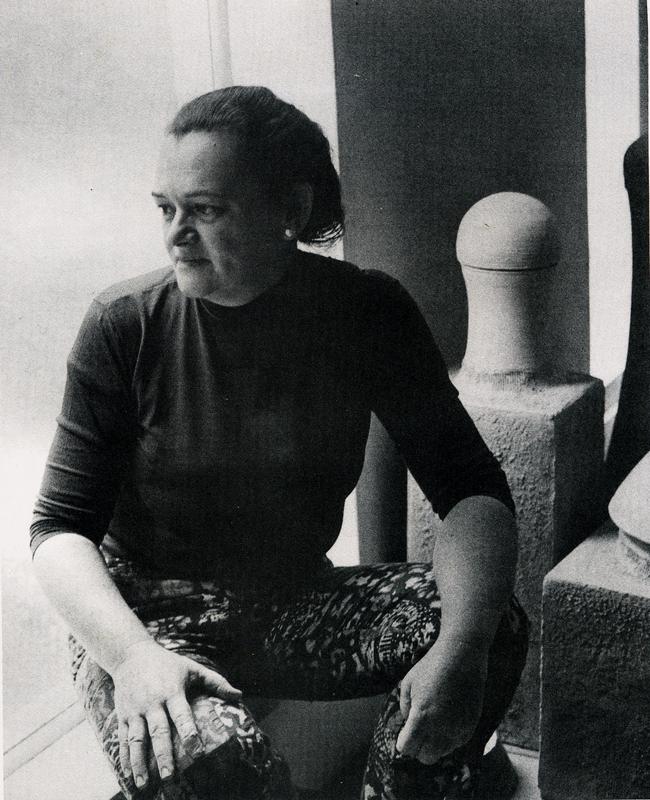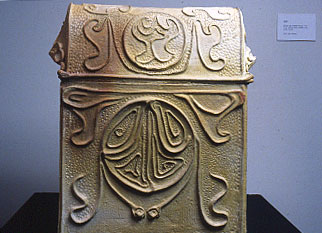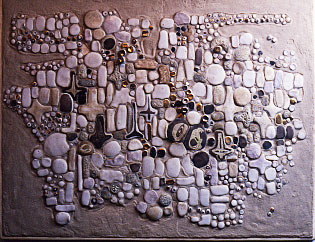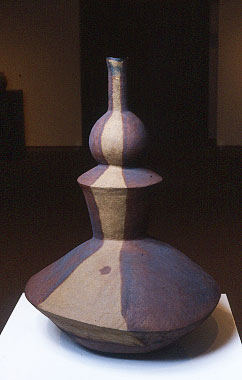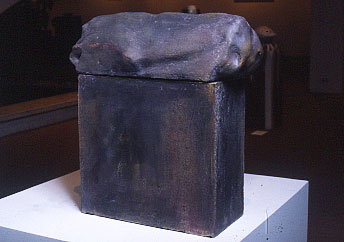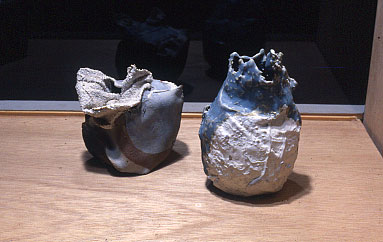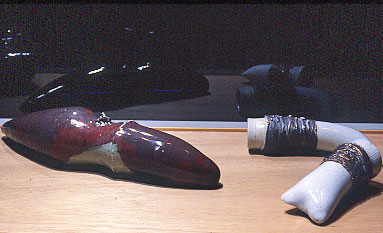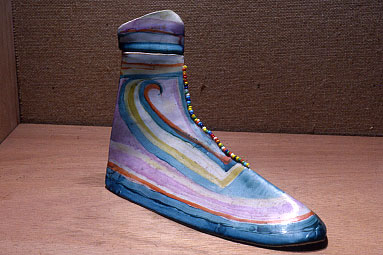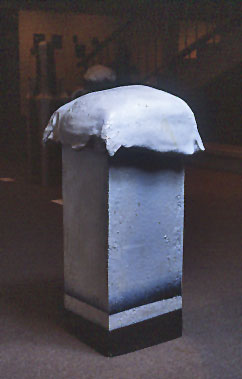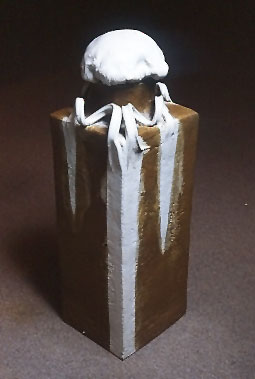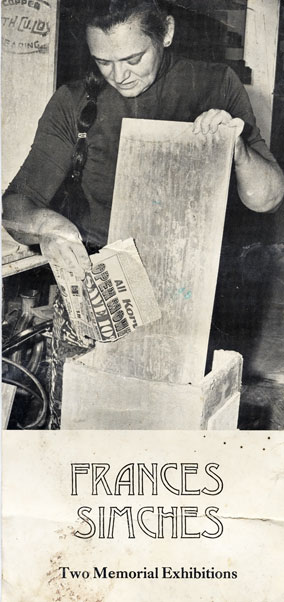JAYNE SHATZ POTTERY
PhD-Prehistoric Ceramics
MA- Pottery and Sculpture
BA - Art History
© 2011 Jayne E. Shatz
In 1984, 1 opened the Albany Ceramic Institute, a ceramic school that was a long time dream of mine. The school included a gallery that honored a great teacher and artist, Frances Simches. Fran was the ceramics professor during my undergraduate years at the SUNY Albany. The gallery’s focus alternated between a retail shop for production ware, and a fine art gallery, exhibiting ceramic sculpture and vessels. This concept integrated Fran's basic philosophical views, which were to promote and respect a comprehensive ceramic field.
The school was a success, but closed down several years later due to personal complications. I felt that Fran's legacy was impeded by not having a vehicle in which to pay homage to her. She was a vibrant, stimulating woman, and a true pioneer of the American ceramic tradition. Fran made a vital contribution to our country's ceramic repertoire; she embraced a life of art and found great joy amidst serious obstacles in working in “this thing called clay”.
As a teacher, Fran was committed to working with clay, and passionately shared this fervor with her students. As an artist, she created a body of work that left an enduring impression on those who knew her. Her work touched all areas of ceramics, from utilitarian ware to fine vessel making. Unfortunately, her life was shortened by an insurmountable battle with cancer. My recollections of her last years were of her courageous battle with this unforgiving disease. When she could no longer work with clay, she created finger weavings and wrote poetry. Her struggle largely influenced my views of how one sustains art in spite of life's difficulties.
Frances Goldsmith was born in Jackson, Michigan in 1920. She became involved in
pottery "through the back door" (as she termed it) during World War II in New York City. At that time, due to the war, there were no men around and the potteries were luring women as apprentices. She left a Spanish teaching position in Michigan in 1945, and went to New York where she met a couple working in pottery. She took on a two-year apprenticeship with them and began studying at night at New York University. There she was hired as a student assistant, and upon receiving her Master's Degree in Ceramics and Education from NYU, she became an instructor there from 1951-1954. She also taught part-time at the Greenwich House Potters, NY from 1948-1955. She pursued postgraduate work at Alfred University until 1965. It was during a summer course at NYU, that Fran met her husband Ray Simches, a student in her pottery class.
They moved to Albany where Ray worked for the State Education Department.
Fran taught ceramics at Russell Sage College, in Troy, NY during 1958-1959. At this time, her studio was in the basement of her home. She collected Hudson River Clay, rich in Albany Slip, around brick factories and refined it for throwing on her kick wheel. Fran always maintained a studio in her home in addition to the studios at the institutions in which she taught. She felt it was essential to live with her work, and as the years progressed, her work became large and sculptural, requiring constant attention.
Initially, Fran made production ware such as casseroles, vases, bowls, and teapots. Her work was
sold through prestigious concerns as George Jensen’s, Rabun Studios, and the International Designers Group, NYC.
She began working with mosaic tiles and produced the "White on White" wall panel, which
created much acclaim. The panel was made of small pieces of clay, mostly white tones, embedded in a background of white sand. She received several awards for this piece. In particular, one from the Designer Craftsmen USA show held at the Museum of Contemporary Crafts in 1960. The American Craftsmen's Council sponsored this show because of a debate over art versus utility. 1,109 craftsmen throughout the US submitted 1,992 objects. 114 pieces were selected, including Fran's panel, which won an award certificate.
Fran became nationally recognized and was invited to submit work to the United States Information Agency Craft Show in 1960, which traveled for two years throughout the United States and Europe. Again, she won an award for her panel in this show and was recognized by the Technical Advisory Committee, for work that was "particularly representative of the best American ceramic mosaics."
At this time, Fran and Ray purchased an old church in Rensselaerville, NY. This would be their home and her last private studio. They removed the choir loft, leaving a shell that was divided into a simple living area, studio, and gallery. One entire side of Fran's bedroom garret was enclosed in glass, overlooking her studio and gas kiln. The home was filled with an eclectic array of ceramic objects and Abstract Expressionist art.
In 1961, she began her final teaching position at the SUNY at Albany in 1970, as she moved into her last teaching studio as Assistant Professor of Art and worked there until 1974. It was in my senior year of college that I met Fran Simches and clay.
She was an incredible teacher. When she lectured, she would go on and on, filling blackboards with information. When she demonstrated, it was like watching a symphony. Her strong, powerful arms quickly centered a huge pile of clay and transformed it gently, yet vigorously into a large pot. Before you knew it, Fran would get off her wheel, and say, "now you do that!" My classmates and I labored throughout the long morning hours "trying to do that" beautifully orchestrated piece as Fran had.
I remember watching Fran construct huge slab forms assembled with plywI ood supports. They were dazzling! She worked in a constructivist style, simple and direct. To create these large containers, she developed a technique that enabled her to make forms of unlimited size yet maintain the crispness of freshly rolled clay slabs. This technique utilized plywood boards as a frame that encased the slabs while the firming process progressed. These wooden frames were bolted on the sides, and once the clay forms were leatherhard, she removed the bolts and the wooden frames, and continued working on the pieces. Some of her boxes reached 45 inches tall. She retained the rigidity of the slab and juxtaposed them with covers that were organic and plastic. This merging of two contrasting forms became representative of her body of work. Refer to Ceramics Monthly magazine, October 1972, pp.30-33.
Form was absolute to Fran. Her large slab pieces applied a force to the space around them. Her glazing was uncomplicated, sometimes imparting a smoked effect, or pure white. The pieces were precise- quiet, subtle colors on strong vibrant constructions.
As the years progressed, I watched Fran's work change from geometric constructions to delicate organic porcelain forms. The cancer had surfaced and she seemed to be in a great hurry to accomplish many things. The strength and vitality of her boxes appeared to be her ultimate public gift; her final work became private, as she now required solitude. It was apparent that she was making peace with her fate. From the organic freely formed covers of her boxes, she continued this motif into her small forms. Formerly, she pursued technical difficulties in the construction and firing of large constructions, she now worked with the intricacies of paper-thin porcelain slabs. The forms were enclosures; continuing her fascination with containment. She worked with thinly rolled porcelain slabs, wrapped around delicately sewn foam rubber forms. She wedged colored oxides into a white body, creating a marbled effect. She electroplated some of the pieces with heavy deposits of metals, a technique that gave her the appearance of a mad scientist, rather than an artist. I think these last pieces were some of her finest work. They embodied the beautiful soft woman she was, beneath the strong and powerful person she portrayed; her art was an intimate revelation of Fran, my teacher, and friend.
Soon, Fran’s illness made it too difficult to continue working in clay, yet she continued creating artwork with exquisite finger weavings.
Fran Simches died in 1975. 1 was one of those very fortunate people who worked with her and knew her well. A teaching career of thirty years left an indelible mark on the world of ceramics. Students from Michigan to New York will always remember this remarkable woman. Her courage to continue when all obstacles lay in her path has truly been an inspiration. To this day, whenever I get fed up with "this pottery thing", I see her bellowing at me, "So what! GO ON! Fran Simches will not be forgotten-she was one of the great ceramic pioneers in our country.
“To be a good potter you should be undefeatable at pottery but quite defeatable in every other aspect of your life. Never let yourself be beaten by the pottery, but be quite willing to give yourself up to every other situation.” Shoji Hamada
Fran’s work represented in this article was from a retrospective exhibit in 1977, co-sponsored by the State University at New York at Albany’s Art Museum, and the Greenwich House Pottery, NYC. All artwork was from private and museum collections.
FRANCES SIMCHES
AMERICAN CERAMIC PIONEER
Chest, 27 in high, stained and fired to
cone 6 reduction,1972
Fran Simches, State University of
New York at Albany, Professor
White On White Tile Panel, white glazed, iron stained and gold lustered pieces, awards from the Director of the Museum of Contemporary Crafts, NYC, 1959
President’s Piece, SUNY Albany, multi slab construction,
raw clay with iron oxide, cone 10 reduction, 1971
Box with Soft Cover, 46 in high, hard edge slab with slab molded "soft" cover, white and black iron glaze, cone 6, reduction, 1971
Hard Box, Soft Cover, 42 in high, hard edge slab with molded "soft" cover,
white and ochre matt glaze, cone 6, reduction, 1966
Covered Box Smoked, using fiberglass and deflocculated casting slip. Smoke effect with nickel oxide and Albany slip, 1971
Porcelain forms, fiber glass and slipped with cobalt and iron oxides wedged in, molded over a fine foam rubber form, 1973
Electroplated forms, copper electroformed on porcelain horn and bone shapes, copper red and clear glaze, cone 10 reduction, 1973
Egyptian Foot, porcelain covered form, 1973
All photographs by Jayne Shatz,
except photo of Fran for the Memorial Exhibitions Invitation. The portrait of
Fran was a photo given to Jayne by
Ray Simches, Fran’s husband.
The photographer is unidentified.
